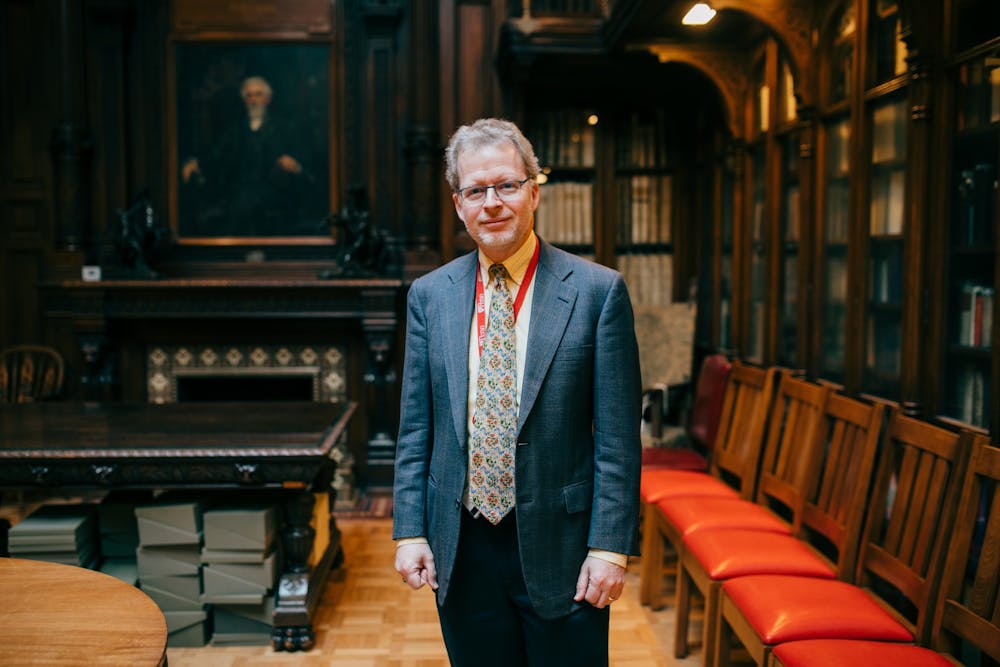“So I’m a caretaker—we are caretakers,” states John Pollack, leaning forward in his cushioned chair. The grandfather clock that stands among the stacks of papers in his sixth floor office seems to stare as he raves about all the library has to offer, and explains his fascination with old books. Pollack is a curator at the Van Pelt–Dietrich Library Center, and more specifically, in the Kislak Center for Special Collections, Rare Books, and Manuscripts.
Though Pollack has been working in the library for over two decades, he didn’t expect to end up at Van Pelt when he first began his academic career. It was his curiosity and inquisitive nature that led him to the profession.
“I found that the questions that I could ask by seeing the original materials, original primary sources, just sort of changed the way I thought about what I was studying…and I became very interested in how the libraries take care of this material.” He focuses specifically in Early American Literature, though he loves old books in general.
Posters advertising upcoming events at the library plaster his walls, and many sheaves of paper and books are heaped on his shelves. His office is something out of a movie—exactly how you might imagine the office of a library curator to look like. Its idiosyncrasies reflect his own.
It's clear that Pollack has no shortage of work to keep track of. As a curator of the Kislak Center and the Horace Howard Furness Shakespeare Library, he's responsible for taking care of books and the special collections. He also assists students and faculty with research, helps acquire new collections and new components of already existing collections, and has a slew of other oddball responsibilities.
The Kislak Center is a library within the Penn library system that contains rare books. This can mean a variety of different things—there are books from the Middle Ages all the way up to books from the 21st century. Special Collections, however, is its own complex entity within the center. Pollack lists some possible inclusions in the collections: “archives, photographs, ephemera, someone’s collection of cinema material or postcards…almost anything really.”
Pollack explains that the sixth floor is a place of exploration. He loves helping students find the right books and materials to answer their questions. Partially due to the inspiration he draws from students’ passion and eagerness to learn, Pollack is always working on something new. Currently, he says he's beginning plans on an exhibit that should go up in about a year and a half.

It's a curator’s job to caretake for the library—an incredibly complex network of collections—and it's truly a team effort to run such an apparatus. Pollack cites the Latin root of “caretaker”—curare, or “to take care of”—as a description of he and his colleagues’ jobs.
The sixth floor has all the eccentricity a university library should have—a model of the solar system graces the main hall, and students lounge on the couches of Moelis Reading Terrace looking out onto the green. Next to the Terrace is the Furness Shakespeare Library, a room housing rare copies of the playwright's many works.
As we walk through the floor, Pollack greets colleagues and students at every turn. He continues to stress the necessity of these spaces being open to students, “I don’t want students to be intimidated by what’s going on here at the library.”
Past the Class of ‘78 Pavilion is the Goldstein Family Gallery, which currently houses “The Bibliophile as Bookbinder,” an exhibit displaying “the angling bindings" of S.A. Neff, Jr., a fisher, and later a bookbinder. Pollack walks through the exhibit, taking care to point out the intricacies and beauty of the bindings.

But arguably the crown jewel of the sixth floor is the Lea Library. Pollack unlocks the doors and ushers me into the personal library of Henry Charles Lea. The soaring ceiling encloses tall, wall–to–wall shelves, a portrait of Lea, several ornate busts, and a balcony upon which even more books are kept.
It doesn't seem that many Penn students are aware of how much the sixth floor of Van Pelt alone has to offer. Not only are there a wide variety of experienced and passionate curators on the floor that are available to assist students, there is a center dedicated specifically to rare texts, and this includes nontraditional “non–literary” texts, such as old comic books.

Students can be more involved than they may think—for example, some students will soon be publishing a previously unpublished notebook of Walt Whitman, which the library helped them accomplish. There was also recently a “Music in the Pavilion” performance of Whitman’s poetry through voice and piano, accompanied by a brief lecture contextualizing the music and an exhibition of the Kislak Center’s collections.
Although many of the Kislak Center's books are available online, the charm and importance of physical copies will never fade, thanks to libraries and their curators. Pollack articulates this perfectly: “A lot of the books are way older than you and me both. We’re both young in this world of what’s around us, you know. We’re just passing through."
Penn students should take full advantage of the library system and the passion of curators like John Pollack, a true steward of ancient knowledge and worldly wisdom. "We just do our best to take care of things while we’re here," he says. "Someone else will take that over after us.”







